Related Research Articles

Lilium philadelphicum, also known as the wood lily, Philadelphia lily, prairie lily, or western red lily, is a perennial species of lily native to North America.

The Botanical Society of Britain and Ireland (BSBI) is a scientific society for the study of flora, plant distribution and taxonomy relating to Great Britain, Ireland, the Channel Islands and the Isle of Man. The society was founded as the Botanical Society of London in 1836, and became the Botanical Society of the British Isles, eventually changing to its current name in 2013. It includes both professional and amateur members and is the largest organisation devoted to botany in the British Isles. Its history is recounted in David Allen's book The Botanists.

Tiarella, the foamflowers, is a genus of flowering plants in the family Saxifragaceae. The generic name Tiarella means "little turban", which suggests the shape of the seed capsules. Worldwide there are seven species, one each in eastern Asia and western North America, plus five species in eastern North America. As of October 2022, the taxonomy of Tiarella in eastern North America is in flux.

Trillium cuneatum, the little sweet betsy, also known as whip-poor-will flower, large toadshade, purple toadshade, and bloody butcher, is a species of flowering plant in the family Melanthiaceae. It is a member of the Trillium cuneatum complex, a subgroup of the sessile-flowered trilliums. It is native to the southeastern United States but is especially common in a region that extends from southern Kentucky through central Tennessee to northern Alabama. In its native habitat, this perennial plant flowers from early March to late April. It is the largest of the eastern sessile-flowered trilliums.

Eurybia schreberi, commonly called Schreber's aster or nettle-leaved Michaelmas-daisy, is a perennial herb in the family Asteraceae. It is native to eastern North America, where it is present in Canada and the United States. The flower heads emerge in the late summer or early fall to show white ray florets and yellow disc florets. It is listed as endangered in Indiana and Iowa, of special concern in Tennessee and possibly extirpated in Maine.

Goodyera oblongifolia is a species of orchid known by the common names western rattlesnake plantain and giant rattlesnake plantain. It is native to much of North America, particularly in the mountains of the western United States and Canada, from Alaska to northern Mexico, as well as in the Great Lakes region, Maine, Quebec and the Canadian Maritime Provinces.

Silene ovata, the Blue Ridge catchfly or ovate-leaved catchfly, is a herbaceous plant in the family Caryophyllaceae. It is a perennial plant growing up to 1.5 m tall, that has numerous white flowers, each finely fringed with a tube. It has large opposite leaves without petioles, which are 5–12 cm (2.0–4.7 in) long and taper to a long point, and 2–5 cm (0.79–1.97 in) wide.

Iris verna, the dwarf violet iris, is a species of flowering plant in the iris family (Iridaceae). It is endemic to the eastern United States from Maryland to Florida along the Atlantic Coast, west to Mississippi, and inland to Kentucky, Tennessee, and Ohio. It occurs in nutrient-poor acidic soils of open to semi-shaded woodlands.
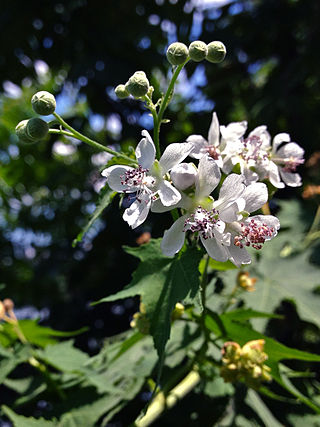
Sida hermaphrodita, known by the common names Virginia fanpetals and Virginia mallow, is a perennial forb native to the eastern United States, which produces white flowers in summer.
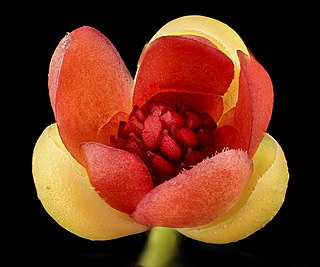
Schisandra glabra, the bay star-vine, is the only American species of this primarily Asian genus. It is native to the southeastern United States and northern Mexico. It grows in Louisiana, eastern Arkansas, southwestern Tennessee, Mississippi, Alabama, northwestern Florida, and Georgia, with isolated populations in Kentucky, South Carolina, North Carolina, and Hidalgo. Despite its wide range, it is considered a vulnerable species. Few populations are secure due to competition from invasive species and habitat loss.
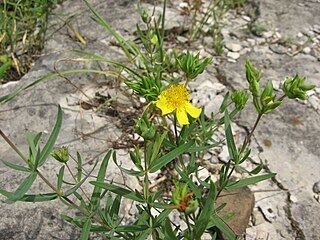
Hypericum dolabriforme, the straggling St. Johnswort or glade St. John's-wort, is a species of flowering plant in the St. John's wort family Hypericaceae native to the United States.
Calycocarpum (cupseed) is a monotypic genus of plants in the family Menispermaceae. The only species currently accepted is Calycocarpum lyonii endemic to the southeastern United States.

Iris prismatica, the slender blue flag or cubeseed iris, is a plant species native to parts of the southern and eastern United States from Maine south to Alabama, as well as to the Canadian provinces of Ontario and Nova Scotia.

Houstonia serpyllifolia, commonly called thymeleaf bluet, creeping bluet, mountain bluet, Appalachian bluet or Michaux's bluets is a species of plant in the coffee family (Rubiaceae). It is native to the eastern United States, where it is found in the central and southern Appalachian Mountains. It has been documented in the states of Pennsylvania, Maryland, West Virginia, western Virginia, North Carolina, South Carolina, Kentucky, Tennessee, Ohio, and northeastern Georgia.

Iris fulva, also known as copper iris, is a species in the genus Iris, it is also in the subgenus Limniris and in the series Hexagonae. It is a rhizomatous perennial, endemic to the southern and central United States. It has copper-red to deep red flowers and bright green leaves.

Leavenworthia torulosa, the necklace gladecress, is a species of plant in the mustard family. It is native to the eastern United States where it is only found near limestone cedar glades of Alabama, Georgia, Kentucky, and Tennessee. It is considered rare in all states it is found except Tennessee, where it is common in the Nashville Basin due to the abundance of available habitat.
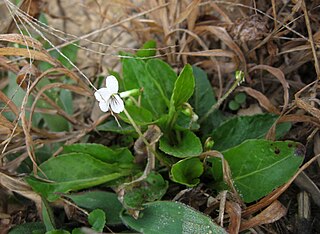
Viola primulifolia, commonly called the primrose-leaf violet, is a species of flowering plant in the violet family. It is native to eastern North America, and possibly also to the Pacific Northwest. Its natural habitat is wet acidic areas that are usually at least semi-open.
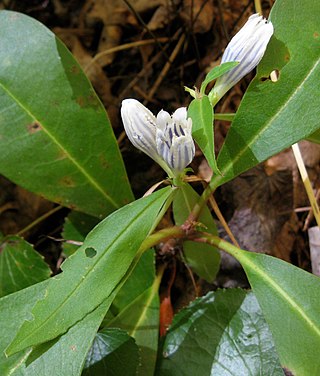
Gentiana decora, commonly called Appalachian gentian or showy gentian is a flowering plant in the gentian family. It is native to North America, where it is endemic to the Southern Appalachian Mountains. Its natural habitat is acidic oak woodlands, most often in somewhat dry conditions.
Robert H. Mohlenbrock is an American botanist and author. Mohlenbrock is an authority on the plants of Illinois, with expertise in floristics, plant taxonomy, endangered species, and wetland flora.
Stellaria corei, with the common names of Tennessee chickweed, star chickweed, Tennessee starwort, and Tennessee stitchwort, is a species of flowering plant native to parts of Eastern USA.
References
- ↑ Chester, Edward W. (20 March 2015). Guide to the vascular plants of Tennessee. The University of Tennessee Press. ISBN 9781621901006.
- 1 2 3 4 Tennessee Native Plant Society
- ↑ "Tennessee-Kentucky Plant Atlas". tennessee-kentucky.plantatlas.usf.edu. Retrieved 31 December 2021.
- ↑ Furlong, Kara (12 June 2014). "Elsie Quarterman, who rediscovered Tennessee coneflower, dies at 103". Vanderbilt University. Retrieved 25 February 2020.